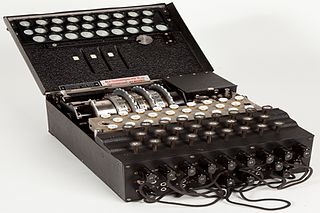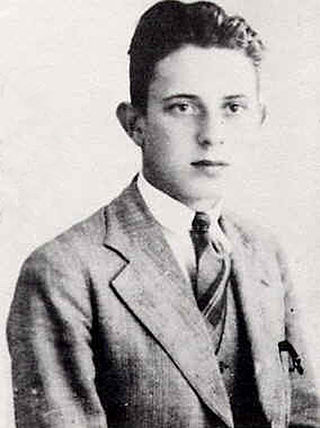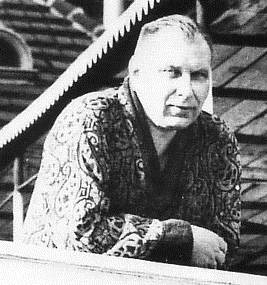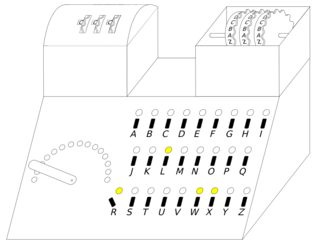
The Enigma machine is a cipher device developed and used in the early- to mid-20th century to protect commercial, diplomatic, and military communication. It was employed extensively by Nazi Germany during World War II, in all branches of the German military. The Enigma machine was considered so secure that it was used to encipher the most top-secret messages.

Jerzy Witold Różycki was a Polish mathematician and cryptologist who worked at breaking German Enigma-machine ciphers before and during World War II.

Henryk Zygalski was a Polish mathematician and cryptologist who worked at breaking German Enigma-machine ciphers before and during World War II.

Hans-Thilo Schmidt codenamed Asché or Source D, was a spy who sold secrets about the German Enigma machine to the French during World War II. The materials he provided facilitated Polish mathematician Marian Rejewski's reconstruction of the wiring in the Enigma's rotors and reflector; thereafter the Poles were able to read a large proportion of Enigma-enciphered traffic.
The Cipher Bureau was the interwar Polish General Staff's Second Department's unit charged with SIGINT and both cryptography and cryptanalysis.

The bomba, or bomba kryptologiczna, was a special-purpose machine designed around October 1938 by Polish Cipher Bureau cryptologist Marian Rejewski to break German Enigma-machine ciphers.
Cryptanalysis of the Enigma ciphering system enabled the western Allies in World War II to read substantial amounts of Morse-coded radio communications of the Axis powers that had been enciphered using Enigma machines. This yielded military intelligence which, along with that from other decrypted Axis radio and teleprinter transmissions, was given the codename Ultra.

The method of Zygalski sheets was a cryptologic technique used by the Polish Cipher Bureau before and during World War II, and during the war also by British cryptologists at Bletchley Park, to decrypt messages enciphered on German Enigma machines.
Cadix was a World War II clandestine intelligence center at Uzès, in southern France, from September 1940 to 9 November 1942. During this period southern France was under the control of Vichy France and not occupied by Nazi Germany. At Cadix, the predominantly Polish team of cryptanalysts who had previously worked at PC Bruno was reassembled, and worked against German and other Axis ciphers, including the German Enigma machine cipher. Cadix shut down when Germany occupied southern France.

The cyclometer was a cryptologic device designed, "probably in 1934 or 1935," by Marian Rejewski of the Polish Cipher Bureau's German section (BS-4), to catalog the cycle structure of Enigma permutations, thereby facilitating the decryption of German Enigma ciphertext.
The Lacida, also called LCD, was a Polish rotor cipher machine. It was designed and produced before World War II by Poland's Cipher Bureau for prospective wartime use by Polish military higher commands. Lacida was also known as Crypto Machine during a TNMOC Virtual Talk.

Gustave Bertrand (1896–1976) was a French military intelligence officer who made a vital contribution to the decryption, by Poland's Cipher Bureau, of German Enigma ciphers, beginning in December 1932. This achievement would in turn lead to Britain's celebrated World War II Ultra operation.
Władysław Kozaczuk was a Polish Army colonel and a military and intelligence historian.
Richard Andrew Woytak was a Polish–American historian who specialized in European history of the Interbellum and World War II.
The card catalog, or "catalog of characteristics," in cryptography, was a system designed by Polish Cipher Bureau mathematician-cryptologist Marian Rejewski, and first completed about 1935 or 1936, to facilitate decrypting German Enigma ciphers.

Marian Adam Rejewski was a Polish mathematician and cryptologist who in late 1932 reconstructed the sight-unseen Nazi German military Enigma cipher machine, aided by limited documents obtained by French military intelligence. Over the next nearly seven years, Rejewski and fellow mathematician-cryptologists Jerzy Różycki and Henryk Zygalski developed and used techniques and equipment to decrypt the German machine ciphers, even as the Germans introduced modifications to their equipment and encryption procedures.

Ludomir Danilewicz (1905–1960) was a Polish engineer and, for some ten years before the outbreak of World War II, one of the four directors of the AVA Radio Company in Warsaw, Poland. AVA designed and built radio equipment for the Polish General Staff's Cipher Bureau, which was responsible for the radio communications of the General Staff's Oddział II.
Leonard Stanisław Danilewicz was a Polish engineer and, for some ten years before the outbreak of World War II, one of the four directors of the AVA Radio Company in Warsaw, Poland.

The AVA Radio Company was a Polish electronics firm founded in 1929 in Warsaw, Poland. AVA designed and built radio equipment for the Polish General Staff's Cipher Bureau, which was responsible for the radio communications of the General Staff's Oddział II.
Edward Fokczyński was one of the four directors of the AVA Radio Company, an electronics firm established in Warsaw, Poland, in 1929. AVA produced radio equipment for the Polish General Staff's Cipher Bureau, which was responsible for the radio communications of the General Staff's Intelligence Section.












